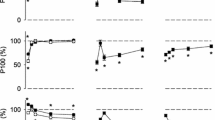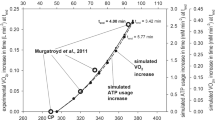Summary
The work output, energy consumption and efficiency during repetitive dynamic contractions were calculated for rat extensor digitorum longus muscle. The muscles performed 40 successive dynamic contractions at 37°C (with occluded bloodflow) with interval durations of either 500, 250 or 167 ms. The muscle-tendon complexes were allowed to shorten at the velocity at which they could exert their highest power output (50 mm · s−1). Work output in the first contraction was the same among the three groups with different interval durations. The reduction in work output during the series of contractions differed among the groups, mainly in the last part of the exercise period. In the group with the longest interval duration, work output steadily decreased over the whole contraction period and at the end was approximately 72% of the output in the first contraction. In contrast, after the 30th contraction, work output decreased at a significantly higher rate of approximately 3% of each contraction in the groups with the intermediate and the shortest interval duration. After the last contraction, work output in these groups was approximately 52% of the work output in the first contraction. These differences in fatigue coincided with differences in the reduction in adenosine 5′-triphosphate and the production of inosine-5′-monophos-phate. Total work output was not significantly different among the three groups with different interval durations, indicating that the different reductions in work output in the last contractions only had a minor influence on total work output of all 40 contractions. Also high-energy phosphate consumption and efficiency were not significantly different over these three exercise periods. Thus with the protocol used no interval dependent pattern of efficiency could be detected.
Similar content being viewed by others
References
Aubert X, Maréchal G (1963) La fraction labile de la thermogén-èse associée au maintien de la contraction isométrique. Arch Int Physiol Biochim 71:282–283
Berden JA, Haan A de, Haan EJ de, Doorn JE van, Hartog AF, Westra HG (1986) Has IMP a regulatory role during fatiguing contraction? IMP-binding sites on the myosin complex of rat muscle. J Physiol (Lond) 381:85P
Benedict FG, Cathcart EP (1913) Muscular work: a metabolic study with special reference to the efficiency of the human body as a machine. Carnegie Institute of Washington Publication no. 187, Washington
Chasiotis D, Bergström M, Hultman E (1987) ATP utilization and force during intermittent and continuous muscle contractions. J Appl Physiol 63:167–174
Cooke R, Pate E (1985) The effect of ADP and phosphate on the contraction of muscle fibres. Biophys J 48:789–798
Cooke R, Franks K, Luciani GB, Pate E (1988) The inhibition of rabbit skeletal muscle contraction by hydrogen ions and phosphate. J Physiol (Lond) 395:77–97
Dickinson VA, Woledge RC (1974) Reduction of shortening heat during a series of tetanic contractions in frog sartorius muscle. J Physiol (Lond) 242:98–99P
Doorn JE van, Goormachtig PFJ, Haan A de (1989) The influence of perchloric acid on ion-pair high performance liquid chromatography of nucleotides. J Chromatogr 496:441–449
Edman KAP, Mattiazzi AR (1981) Effects of fatigue and altered pH on isometric force and velocity of shortening at zero load in frog muscle fibres. J Muscle Res Cell Motil 2:321–334
Edman KAP, Lou F (1990) Changes in force and stiffness induced by fatigue and intracellular acidification in frog muscle fibres. J Physiol (Lond) 424:133–149
Enoka RM, Rankin LL, Stuart DG, Volz KA (1989) Fatigability of rat hindlimb muscle: associations between electromyogram and force during a fatigue test. J Physiol 408:251–270
Gonzales-Serratos H, Garcia M, Somlyo A, Somlyo AP, McClellan G (1981) Differential shortening of myofibrils during development of fatigue. Biophys J 33:224a
Haan A de (1990) High-energy phosphates and fatigue during repeated dynamic contractions of rat muscle. Exp Physiol 75:851–854
Haan A de, Jones DA, Sargeant AJ (1989a) Changes in velocity of shortening, power output and relaxation rate during fatigue of rat medial gastrocnemius muscle. Pflügers Arch 413:422–428
Haan A de, Lodder MAN, Sargeant AJ (1989b) Age-related effects of fatigue and recovery from fatigue in rat medial gastrocnemius muscle. Q J Exp Physiol 74:715–726
Kushmerick MJ, Paul RJ (1977) Chemical energetics in repeated contractions of frog sartorius muscles at 0°C. J Physiol (Lond) 267:249–260
Lodder MAN, Haan A de, Sargeant AH (1991) Effect of shortening velocity on work output and energy cost during repeated contractions of the rat EDL muscle. Eur J Appl Physiol 62:430–435
Taylor DJ, Styles P, Matthews PM, Arnold DA, Gadian DG, Bore P, Radda GK (1986) Energetics of human muscle: exercise-induced ATP depletion. Magn Reson Med 3:44–54
Westra HG, Haan A de, Doorn JE van, Haan EJ de (1986) IMP production and energy metabolism during exercise in rats in relation to age. Biochem J 239:751–755
Author information
Authors and Affiliations
Rights and permissions
About this article
Cite this article
Lodder, M.A.N., de Haan, A. Muscle fatigue and efficiency in relation to interval duration of successive contractions. Europ. J. Appl. Physiol. 64, 42–46 (1992). https://doi.org/10.1007/BF00376438
Accepted:
Issue Date:
DOI: https://doi.org/10.1007/BF00376438




